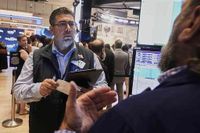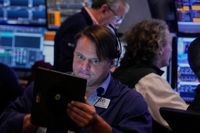Wall Street kicked off the week by clinging tightly to its record heights, as investors paused to catch their breath ahead of a slate of major events likely to shape the financial landscape in the days to come. On Monday, August 18, 2025, the S&P 500 crept down by less than 0.1%, a modest slip after a remarkable run of three consecutive all-time highs. The Dow Jones Industrial Average edged lower by 33 points, or 0.1%, while the Nasdaq composite managed a fractional gain, rising by less than 0.1%. These small moves belied the underlying tension and anticipation on the trading floor, where traders balanced optimism with caution as they eyed upcoming reports and Federal Reserve signals.
The numbers themselves painted a picture of a market that, for now, is content to hover near its peaks. According to data from Barchart and the Associated Press, the S&P 500 index closed at 6,449.15, down just 0.65 points (or 0.01%). The Dow ended at 44,911.82, slipping by 34.30 points (0.08%), and the Nasdaq 100 index ticked up to 23,713.76, a gain of 1.69 points (0.01%). These figures reflect a market that, while not surging, is certainly not retreating either—at least not yet.
Amid the relative calm, a few companies made notable moves. Novo Nordisk’s U.S.-traded shares jumped 3.7% after the Danish pharmaceutical giant announced that U.S. regulators had approved its Wegovy drug as a treatment for a liver disease commonly found in overweight and obese individuals. This regulatory green light was seen by many as a significant milestone for the company, and investors responded enthusiastically.
Elsewhere, Soho House & Co. Inc. saw its shares skyrocket by 14.9% after revealing a deal with an investor group led by hotel operator MCR, which agreed to buy shares at $9 in cash. The news sent a jolt through the leisure and hospitality sector, with Soho House’s global network of membership clubs suddenly thrust into the financial spotlight.
Retailers, meanwhile, presented a mixed picture ahead of their highly anticipated earnings reports scheduled throughout the week. Home Depot slipped by 1.2% as it prepared to announce results on Tuesday, August 19. Target, on the other hand, rose 1.9% ahead of its Wednesday report, and Walmart added 0.7% before its own earnings release on Thursday. These companies, along with others like Estee Lauder (down 0.25%) and Ross Stores (down 0.60%), are expected to provide a window into the health of American consumers at a time when the job market appears to be shifting. As the AP noted, the labor market has morphed into a landscape where relatively few workers are being fired, but hiring has also slowed, raising questions about the durability of household spending.
UnitedHealth Group Inc. bucked the trend, climbing 1.47%, while Applied Materials gained 1.10%. Dayforce Inc. was a standout, soaring by an eye-popping 25.98%, further highlighting the market’s penchant for rewarding select winners even as the broader averages tread water.
Digging deeper into market dynamics, Oppenheimer Asset Management remains notably bullish on the technology, consumer discretionary, and industrial sectors. As of August 18, 2025, the firm continues to overweight cyclical stocks over defensive ones, favoring information technology, consumer discretionary, and communication sectors. This preference reflects a belief that the current bull market—driven in part by a surge in spending around artificial intelligence and other technological innovations—still has legs, even if the path forward is likely to be bumpy.
This divergence between the so-called "haves" and "have-nots" in the stock market has not gone unnoticed. Lisa Shalett, chief investment officer at Morgan Stanley Wealth Management, warned that the dominance of a handful of Big Tech companies could be increasing risk. "The danger is that investors could look at how much the broad S&P 500 index has surged since its low point in April and extrapolate the success of the few to the gains of the many," she said, according to the Associated Press. In other words, while some companies and sectors are thriving, others may be left behind if the economy slows or inflation remains stubbornly high.
Speaking of inflation, all eyes are now on the Federal Reserve and its upcoming gathering in Jackson Hole, Wyoming. On Friday, August 22, Fed Chair Jerome Powell is set to deliver a speech that could provide crucial clues about the central bank’s next move. Investors are hoping Powell will signal a willingness to cut interest rates at the Fed’s September meeting—a move that could offer relief to borrowers and potentially inject fresh energy into the markets. The 10-year Treasury yield, a key barometer of investor sentiment, held steady at 4.33% on Monday, reflecting a wait-and-see attitude as traders digest mixed signals on inflation and employment.
Recent updates on inflation have been a mixed bag, only adding to the uncertainty. The Fed faces a delicate balancing act: lowering rates could stimulate the economy by making it cheaper for households and businesses to borrow, but it also risks fueling inflation. The central bank’s dual mandate—to keep the job market healthy while maintaining price stability—means that any decision is likely to have ripple effects across the economy.
International markets mirrored some of this uncertainty. European indexes mostly fell in their first trading session after President Donald Trump’s inconclusive summit with Russian President Vladimir Putin regarding the ongoing war in Ukraine. Trump also met with Ukrainian President Volodymyr Zelenskyy on Monday, but details from those discussions were scant. In Asia, the results were mixed: Japan’s Nikkei 225 rose by 0.8%, while South Korea’s Kospi dropped 1.5%.
As the week unfolds, investors will be watching not just for corporate earnings and Fed pronouncements, but also for signs of how different segments of the U.S. population are faring. The divide between wealthy households and everyone else seems to be widening, and the same could be said for the stock market itself, where a handful of companies account for a disproportionate share of gains. It’s a situation that brings both opportunities and risks, and one that is likely to remain in sharp focus as new data rolls in.
For now, Wall Street’s standstill feels less like a pause and more like a deep breath before the next big move. With so many variables in play—from central bank policy to geopolitical tensions and shifting consumer fortunes—traders and investors alike are bracing for a week that could prove pivotal for the markets and the broader economy.


